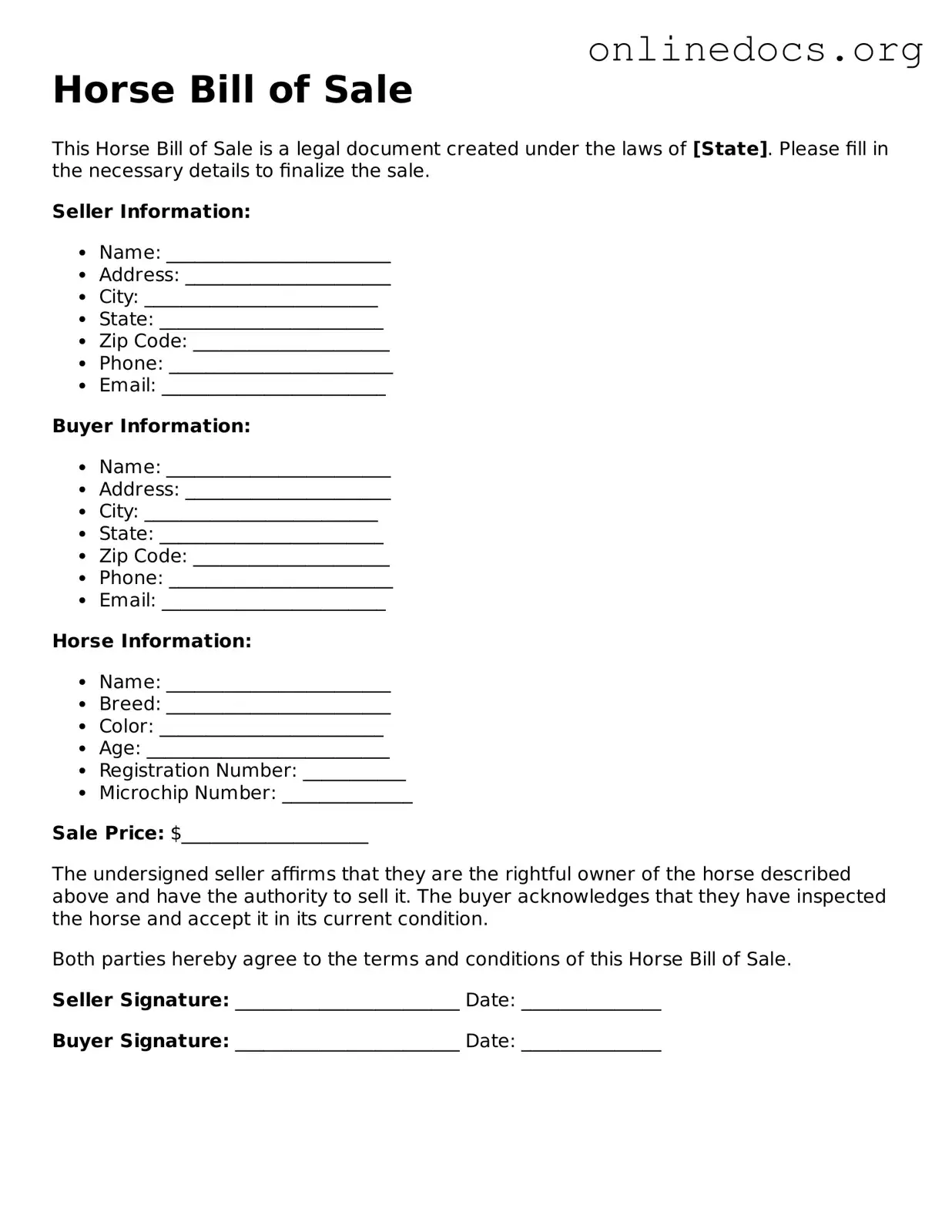The Horse Bill of Sale form is similar to a Vehicle Bill of Sale. Both documents serve as proof of transfer of ownership from one party to another. Just as a Vehicle Bill of Sale includes details about the make, model, year, and VIN of the vehicle, the Horse Bill of Sale includes information about the horse, such as breed, age, and registration number. Both documents often require signatures from both the seller and the buyer to validate the transaction.
Another document akin to the Horse Bill of Sale is the Pet Adoption Agreement. This agreement outlines the terms under which an animal is adopted, including health information and any obligations of the new owner. Like the Horse Bill of Sale, it provides a record of the transfer of ownership and may include details about the pet's background and care requirements. Both documents emphasize the responsibilities that come with ownership.
The Boat Bill of Sale shares similarities with the Horse Bill of Sale as well. Both documents detail the specifics of the item being sold, such as make, model, and condition. They also serve as legal proof of ownership transfer. Just like the Horse Bill of Sale, the Boat Bill of Sale often requires signatures from both parties and may include warranties or disclosures about the item’s condition.
In New York, clarity in agreements is essential, and having a well-drafted document is key for involved parties. For those looking into leasing property, the New York Lease Agreement form serves as a vital resource, providing clear terms and conditions between landlords and tenants. To learn more about this, you can visit legalformspdf.com, which offers comprehensive information and templates that help in creating a legally binding contract, ensuring both parties are aware of their rights and responsibilities.
A Farm Equipment Bill of Sale is another document that parallels the Horse Bill of Sale. This form is used when buying or selling agricultural machinery. It includes information about the equipment, such as make, model, and serial number, similar to how the Horse Bill of Sale details the horse. Both documents are essential for establishing ownership and may include terms related to warranties or liabilities.
The Livestock Bill of Sale is closely related as well. This document is specifically used for the sale of livestock, including cattle, sheep, and goats. Like the Horse Bill of Sale, it includes descriptions of the animals and ensures that ownership is legally transferred. Both forms help protect the rights of the buyer and seller in the transaction.
The Real Estate Purchase Agreement also shares some characteristics with the Horse Bill of Sale. While it pertains to property rather than animals, both documents outline the terms of a sale and include specific details about the item being sold. The Real Estate Purchase Agreement requires signatures from both parties and often includes contingencies, just like the Horse Bill of Sale may include conditions regarding the horse's health or training.
A Motorcycle Bill of Sale is similar in function to the Horse Bill of Sale. Both documents are used to document the sale and transfer of ownership of a vehicle or animal. They include important details such as the condition and identifying features of the motorcycle or horse. Both require signatures from the seller and buyer to finalize the transaction.
The Equipment Lease Agreement can also be compared to the Horse Bill of Sale. While this document is used for leasing rather than selling, it outlines the terms of use and responsibilities of both parties. In the context of horse leasing, it may detail the horse's care and maintenance, similar to how a Horse Bill of Sale outlines ownership responsibilities.
The Sales Agreement for a Business includes elements that are similar to the Horse Bill of Sale. This document outlines the terms of sale for a business, including the assets being transferred. Both documents require detailed descriptions of what is being sold and the conditions of the sale, ensuring that both parties are aware of their rights and obligations.
Lastly, the Equipment Purchase Agreement is akin to the Horse Bill of Sale as it details the sale of specific equipment, often used in various industries. It includes descriptions, terms of sale, and responsibilities for both the buyer and seller. Just like the Horse Bill of Sale, it serves as a legal document to confirm the transfer of ownership.
